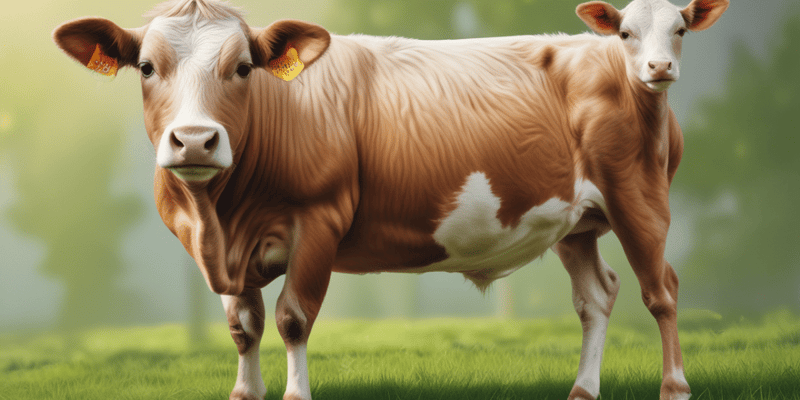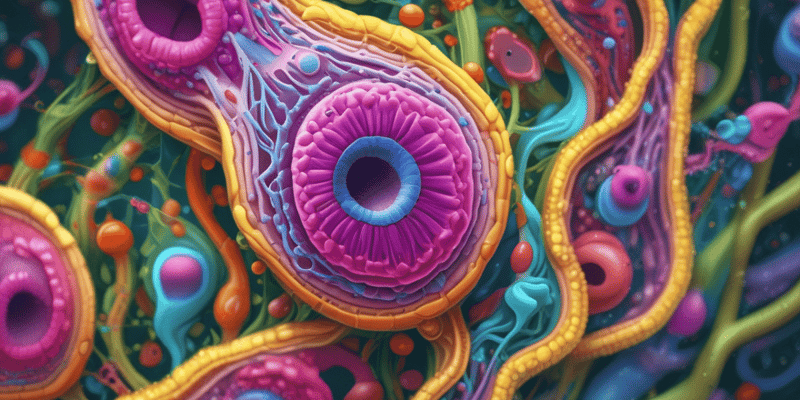41 Questions
What is the approximate percentage of women diagnosed with infertility?
13%
What is the term for the inability of a couple with regular intercourse to conceive within 1 year?
Infertility
What is the probability of achieving a live birth in 1 menstrual cycle?
Fecundity
What is the term for the likelihood of conception per month of exposure?
Fecundability
What percentage of couples with regular intercourse will have difficulties in conceiving?
10-15%
What percentage of couples are sterile?
1-2%
What is the term for an intrinsic inability to achieve pregnancy?
Sterility
What is the abbreviation for Assisted Reproductive Technologies?
ART
What is the term for a reversal of a chromosome segment from end to end?
Inversion
What type of disorders can occur on any of the chromosomes?
Faulty genes can cause any type of disorder
What is the risk of birth defects when certain factors are present?
Higher
Why does screening for birth defects begin by assessing your risk factors?
Because it helps to identify the likelihood of birth defects
What is an example of a genetic disorder that can occur on any of the chromosomes?
All of the above
What type of inversion is characterized by a breakage within the same chromosome arm?
Paracentric inversion
What is the significance of a family history of a genetic disorder in assessing risk factors?
It increases the risk of birth defects
What is the term for a genetic disorder that is more common in certain ethnic groups?
Ethnic-specific disorder
What is genetic mosaicism?
A condition in which a single organism possesses more than one genetic line as the result of genetic mutation
What is the main difference between genetic mosaicism and chimerism?
Genetic mosaicism arises from mutation, while chimerism arises from fusion of multiple zygotes
What is anaphase lagging?
A mechanism by which mosaicism arises in the preimplantation embryo
What is the result of a mutation in one cell during development?
The mutation is only present in a fraction of the adult cells
What is the consequence of genetic mosaicism?
The mutation is only present in a fraction of the adult cells
What is endoreplication?
A mechanism by which mosaicism arises
What is chromosome nondisjunction?
A mechanism by which mosaicism arises
Which of the following is NOT a mechanism by which mosaicism arises?
Mitosis
Which of the following is a cause of infertility in females?
Tubal diseases
What is the purpose of hyperstimulation of the ovaries in IVF?
To collect the ovum at the ovulatory stage
What is the method of fertilization in ICSI?
Injecting one sperm into the ovum
What is the purpose of PGD in IVF?
To diagnose genetic disorders in the embryo
Which of the following is a genetic disease that can be treated by IVF+PGD?
Aneuploidy
What is the result of IVF after 3-5 days?
Transfer of the embryo to the uterine cavity
What is the method of fertilization in IVF?
Putting the sperm and ovum in the same place and waiting for fertilization
What is the cause of single gene disorders?
A faulty gene that can be passed from parent to child
What is the year in which IVF was first performed?
1978
What is the primary reason why somatic mosaicism is not generally inheritable?
It affects only somatic cells.
What is the most common form of aneuploidy?
Trisomy
What is the result of a nondisjunction event in an early mitosis?
Loss of a chromosome from some trisomic cells.
What is the approximate percentage of an individual's genomic variation contributed by mosaic mutations?
6.5%
What is the term for the chromosomal disorder characterized by an extra chromosome 21?
Down syndrome
What is the term for the chromosomal disorder characterized by a missing X chromosome in females?
Turner syndrome
What is the term for a condition where there is an extra chromosome?
Trisomy
What increases the risk of having a child with aneuploidy?
A woman's age
Study Notes
Genetic Pathology of IVF
- Infertility is defined as the inability of a couple to conceive within 1 year, with primary infertility applying to those who have never conceived, and secondary infertility to those who have conceived at some time in the past.
- Sterility implies an intrinsic inability to achieve pregnancy, whereas infertility implies a decrease in the ability to conceive and is synonymous with subfertility.
- Fecundity is the probability of achieving a live birth in 1 menstrual cycle, and fecundability is the likelihood of conception per month of exposure.
General Aspects of Infertility
- The prevalence of women diagnosed with infertility is approximately 13%, with a range from 7 to 28%, depending on the age of the woman.
- The incidence of primary infertility has increased, with a concurrent decrease in secondary infertility, likely due to social changes such as delayed childbearing.
- 10-15% of couples with regular intercourse will have difficulties in conceiving, and 1-2% of couples will be sterile.
- The number of infertility visits has increased over the past decades, partly due to couples voluntarily delaying childbearing in favor of establishing careers, which may experience an age-related decline in fertility.
Causes of Infertility
- Both male and female partners can have causes for infertility.
- Female causes include:
- Tubal diseases
- Ovulatory disturbances
- Endometrial diseases
- Endometriosis
- Genetic diseases
- Unexplained infertility
- Male causes include:
- Low sperm count, motility, or morphology
- Azoospermia
- Genetic diseases
- Ejaculatory disturbances
- Impotence
- Hormonal disturbances
IVF (In Vitro Fertilization)
- First performed in 1978
- Ovum at ovulatory stage is collected by needle after hyperstimulation of the ovaries
- Sperm is collected from the male partner, or extracted directly from the testis by operation (mTESE)
- Sperm and ovum are fertilized by two ways: IVF (putting sperm and ovum in the same place) or ICSI (injecting one sperm into the ovum)
- 3-5 days after fertilization, the embryo is transferred to the uterine cavity
Genetic Diseases Treated by IVF+PGD
- Single gene disorders
- Translocations, inversions, and insertions (chromosome structural defects and recombinations)
- Mosaicism
- Aneuploidy screening
Single Gene Disorders
- Inherited disorders caused by a faulty gene that can be passed from parent to child
- Faulty genes can occur on any of the chromosomes
- Examples include:
- Thalassemias
- Muscular Distrophies
- Genetic metabolic diseases
- Cystic Fibrosis
Chromosome Structural Defects
- Inversions: a chromosome rearrangement in which a segment of a chromosome is reversed end to end
- Two types of inversions: paracentric and pericentric
Mosaicism
- A condition in which a single organism possesses more than one genetic line as a result of genetic mutation
- Various genetic lines result from a single fertilized egg
- Can result from mechanisms including chromosome nondisjunction, anaphase lag, and endoreplication
- Somatic mosaicism is not generally inheritable as it does not affect germ cells
Aneuploidy Screening
- The risk of having a child with an aneuploidy increases as a woman ages
- Mostly, aneuploidies are unpredictable
- Trisomy is the most common aneuploidy, with an extra chromosome
- Examples include:
- Down syndrome (trisomy 21)
- Patau syndrome (trisomy 13)
- Edwards syndrome (trisomy 18)
- Monosomy is another type of aneuploidy, with a missing chromosome
- Examples include Turner syndrome, in which a female has a missing or damaged X chromosome
This quiz covers the basics of mosaicism and trisomies, including somatic mosaicism and its non-inheritable nature, as well as the most common form of mosaicism found through prenatal diagnosis.
Make Your Own Quizzes and Flashcards
Convert your notes into interactive study material.
Get started for free



